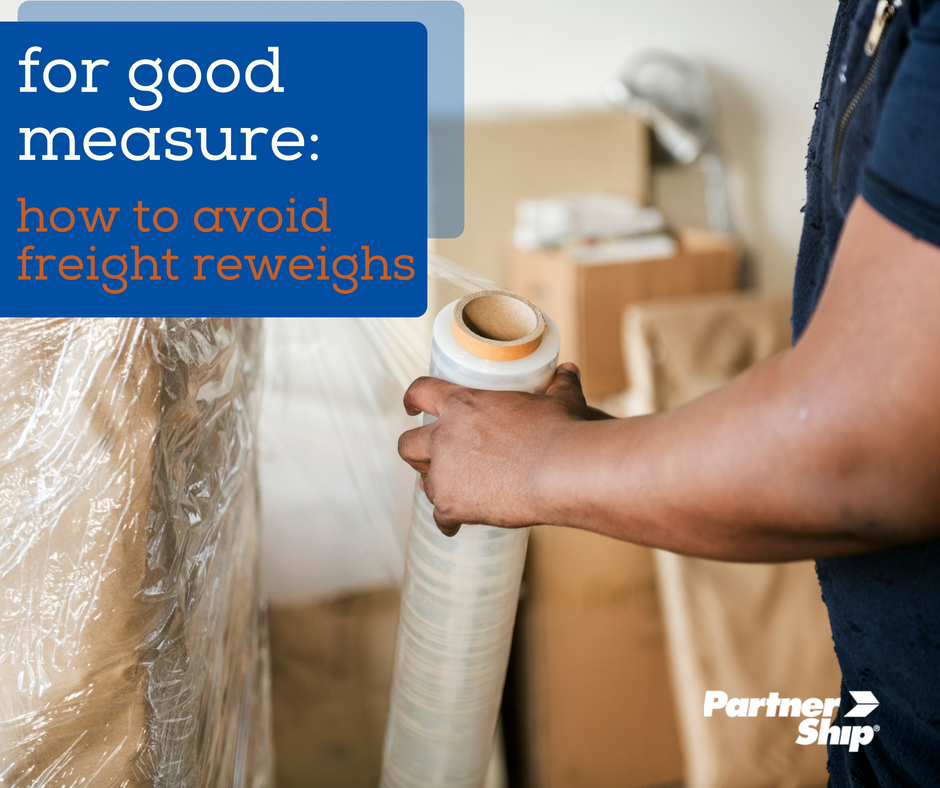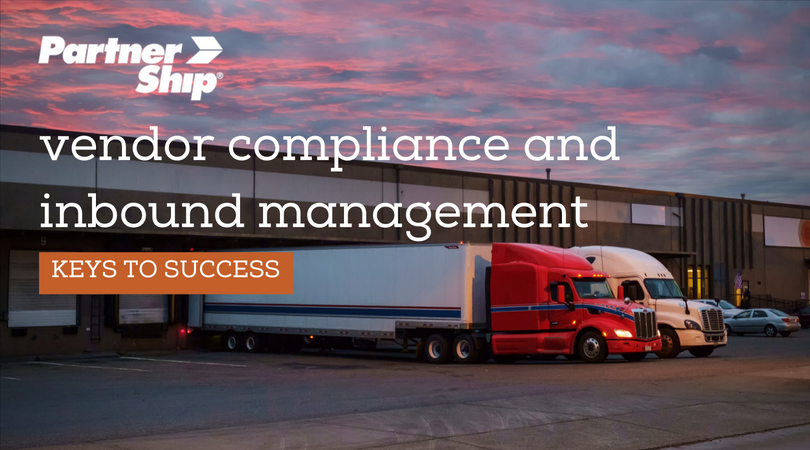the PartnerShip Connection blog
the PartnerShip Connection blog
the PartnerShip Connection blog
the PartnerShip Connection blog
the PartnerShip Connection blog
-
For Good Measure: How to Avoid Freight Reweighs
07/26/2018 — Jen Deming

LTL shipping requires plenty of diligence and double checking on behalf of the shipper. All may seem in order: you've used proper packaging, paperwork is up to date, shipping addresses reviewed, accessorial requirements checked, and you are confident you are using the proper freight class. Then it happens. Your shipment is delivered safe and sound, but when the invoice arrives, your bill is nearly $100 over what you had anticipated. On further review, you learn you've been hit with a reweigh fee by the carrier. How did this happen?
Freight reweighs are becoming more and more frequent, especially as dimensional and density based pricing becomes more common. It's important to understand what constitutes a reweigh, and what puts your shipment at risk. Many shippers, particularly small businesses, do not have certified scales that are large enough to accurately measure a larger LTL (less-than-truckload) shipment. This means that many of the weights listed on the BOL (Bill of Lading) are approximations, and carriers are pretty vigilant at checking for inaccuracies with their own certified equipment. A freight reweigh occurs when a carrier inspects and weighs the shipment and when the actual weight and the weight listed on the BOL do not match. One of the primary factors used to determine freight cost is weight, and in many cases, affects freight class as well. Often, a carrier will charge not only for the difference in weight, but also a fee for the freight reweigh itself.
To avoid a freight reweigh, it is so important that shippers try to avoid "guessing" their shipment weight. If your business does have a certified commercial scale, you are a step ahead of many other shippers. Be sure to have it calibrated and checked frequently to avoid miscalculations. If you do not have a scale, it is key to obtain accurate measurements and weights for ALL of the materials being shipped. This can be even more challenging if you are shipping an assembled, finished product made up of several separate pieces and different classifications. Add up materials used on product spec sheets, catalogue listings, and product invoices to get as accurate a weight as possible. It can be beneficial to look at any inbound shipping invoices for any pieces of your finished product that were shipped to you as a supply order. In short, don't be tempted to take shortcuts. It pays to take the time to measure individually and make educated and precise estimates.
Another mistake that many shippers make that encourage freight reweighs is neglecting to include packaging/packing materials in their calculation of gross weight. An average 48x40 pallet weighs around 30-40 lbs, and if you are shipping a multi-pallet load, that extra weight adds up fast. While it's always best to avoid guessing your shipment's weight, in the case shippers aren't able to weigh their shipments on a calibrated scale, it is important to factor this figure in the total. Additional materials used to protect your shipment such as molded plastic corner reinforcements, fiberboard, wooden stabilizers, and even foam inserts can increase weight, especially if you have a larger LTL shipment.
It's key to remember that accurate weight is not the only factor that affects your shipment- it helps to determine your freight class, as well. For heavier, denser items that fall into the lower NMFC classifications, total weight of the shipment is used to calculate at price-per-pound. For less dense shipments that take up more volume, your freight class can be higher and your shipping more expensive. If you happen to overestimate the weight of your shipment, and it falls into one of these higher freight classes, you will be charged more at the higher freight class. It is crucial for shippers to know their precise weight, freight class, and your freight density in order to estimate accurate shipping charges.
Even if you feel you've got everything in order, freight shipping can always lead to some surprises. While it's never a good idea to cut corners or knowingly try to mislead a carrier in the hopes of saving a couple bucks, sometimes even thorough shippers can get hit with some unforeseen charges. Don't let freight reweighs be one of them. The freight experts at PartnerShip have your back and can help make sure you are shipping smarter. If you have questions about determining your freight class or how working with a 3PL can help lower your shipping costs, call 800-599-2902 or email sales@PartnerShip.com to learn more.

Click to read more... -
And the PartnerShip June Carrier of the Month Is…
07/20/2018 — PartnerShip

Without high-quality freight carrier partners, our job would be much harder, and the economy would move much slower. We love recognizing our awesome carriers for a job well done because they help us help our customers ship smarter and stay competitive.
June’s Carrier of the Month is Boyko Trucking LLC of Richfield, Ohio! They have been in business since 2009 and specialize in LTL and full truckload shipping.
The PartnerShip Carrier of the Month program was created to recognize carriers that go above and beyond to help our customers ship and receive their freight. PartnerShip team members nominate carriers that provide outstanding communication, reliability, and on-time performance.
For being our June 2018 Carrier of the Month, Boyko Trucking gets lunch for the whole office and a nifty framed certificate to proudly hang on their wall. The gestures may be small but our appreciation is huge!
Interested in becoming a PartnerShip carrier? We match our freight carriers’ needs with our available customer loads because we understand that your success depends on your truck being full. If you’re looking for a backhaul load or shipments to fill daily or weekly runs, let us know where your trucks are and we’ll match you with our shippers’ loads. If your wheels aren’t turning, you’re not earning.
Click to read more... -
Keys to Success for Vendor Compliance and Inbound Shipping
07/10/2018 — Leah Palnik

For many retailers, obtaining vendor compliance and maintaining smooth inbound shipping operations may seem like a tall order. However, with the right planning and follow through, it is achievable. By following these keys to success, you’ll be on your way to reducing your freight costs, avoiding chargeback issues, and creating efficient operations.
Developing an effective routing guide
The very foundation of achieving vendor compliance is developing an effective routing guide. Routing guides provide shipping instructions to your vendors that help you gain control of your inbound shipments. They often include modes and carriers for specific lanes, as well as rate and service requirements.In order to create routings that are best for your business, you’ll need to consider several factors. Price, transit time, and reliability are all important when selecting a carrier and determining how to have your product shipped. For different services and weight breaks, you want to designate a carrier that provides you with the best rate and can deliver your product in the time you need.
Conducting an in-depth analysis of your inbound shipments can be time-consuming but necessary when determining your routing instructions. This is where working with the right freight broker can make a huge difference. The broker you work with should provide inbound management services that help determine the routings that will be best for your business and will create the routing guide for you – saving you valuable time.
Maintaining good relationships with your vendors
For smooth inbound shipping, you want to have a good rapport with your vendors. Like any other relationship, communication is key. For example, when you send your routing guide out to your vendors, it’s a good idea to include a request for confirmation. However, you won’t always receive one. If that’s the case, following up and opening the lines of communication will be your best bet to ensure vendor compliance.If your vendors aren’t using your routing instructions after receiving your routing guide, you’ll need to follow up with a call or email. When you have a good relationship with your vendor, you’ll have the right point-of-contact and will be able to resolve the issue quickly. If not, you could have a harder time achieving vendor compliance.
Maintaining a relationship with your vendors can be difficult and time-consuming. This is another area where working with the right freight broker can make a difference. When selecting a freight broker, ask about experience in your industry. Quality freight brokers familiar with your industry will already have an established relationship with many of your vendors, which will help with compliance efforts.
Perfecting your order forecasting
Managing your inventory can be challenging. But the advantages of forecasting and planning your orders ahead of time are too great to ignore. When you don’t plan ahead and then need your product within a shorter time-frame, you will have to rely on costly expedited services. Spending the time up front to make sure your orders are placed with ample time will be better than spending the extra money in the long-run.Also, with more lead time, you’ll be in a better position to handle any issues that arise. For example, if your shipment gets lost or damaged in transit and you need your product immediately, you’ll be out of luck. In that event, you’ll need to file a freight claim which doesn’t always guarantee compensation and is often a lengthy process.
If you’re not able to place your orders ahead of time, it’s a good idea to consider freight insurance. Unlike relying on carrier liability coverage, you won’t have to worry about if the carrier is found liable or not and often times you’ll get paid out much faster – making it easier to resume operations as normal.
Conducting regular reviews for improvements
Once you do have a routing guide in place and have vendor compliance, you can’t just set it and forget it. It’s best to review your routing instructions periodically so that you’re always getting the best rates and service possible.You can choose to set aside a specific time each year to do a review. But if you make any changes throughout the year with your orders or any other factor that affects your shipments, you’ll want to take that time to evaluate and update if necessary.
It’s also important to stay on top of carrier rate increases, accessorial changes, and NMFC updates. These kinds of changes can have a significant effect on your freight costs and you'll want to make sure that you fully understand how these changes will affect your specific shipments. For example, carriers announce general rate increases every year and will present an average increase. If you simply use that average to judge how your costs will be affected, your budget will most likely be off. The increases vary greatly across the board depending on a number of characteristics, so it's important to evaluate them based on your specific shipments.
Partnering with the right freight broker
The keys to vendor compliance and inbound shipping management are easy to master when you work with the right freight partner. PartnerShip can help conduct a complete inbound shipping analysis, create a routing guide, and send routings on your behalf for vendor compliance. Contact us today to get started, or download our free white paper to learn more about managing your inbound shipments!
Click to read more...